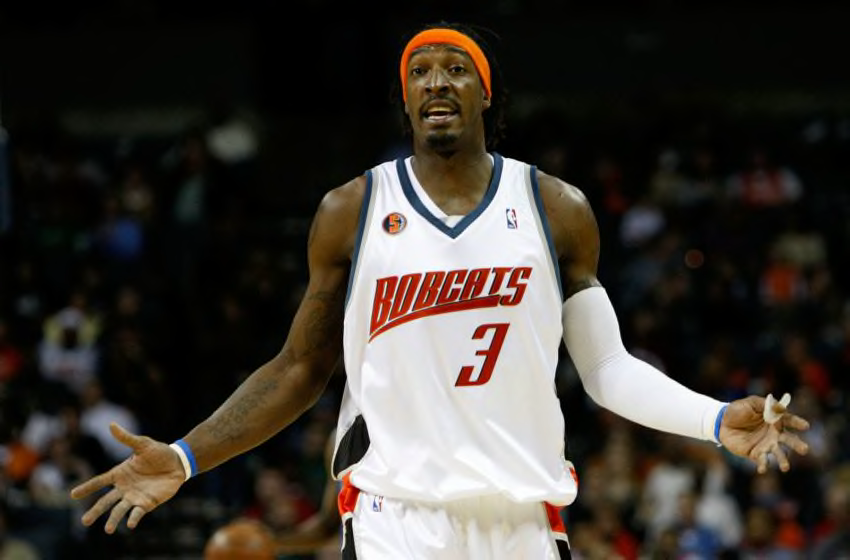
Photo by Streeter Lecka/Getty Images
As the most memorable face of a now defunct Charlotte Bobcats franchise, Gerald Wallace doesn’t get as much love as he probably deserves.
There’s no beating around the bush: The Charlotte Bobcats were mostly a terrible, miserable, unwatchable basketball team during their 10 years of existence.
They made the playoffs twice in that stretch, getting swept in the first round both times. They compiled a 273-511 record, giving them a .348 win percentage, and they never won more than 44 games in a season.
Throw in that 7-59 campaign in 2011-12, and the only memorable distinctions the Bobcats have as an NBA franchise are posting the lowest win percentage (.106) in NBA history and missing out on Anthony Davis in the subsequent NBA Draft when they fell to pick No. 2.
But as much as the Bobcats, their simplistic logo and their very memory are entirely forgettable — especially one the franchise switched back to the more welcome Charlotte Hornets brand in 2014 — there’s one player who doesn’t deserve to be lost in that shuffle: Gerald Wallace.
During this time of quarantine, random things start trending out of the blue. This Twitter prompt led to one of them, because the only correct answer to such a question — Gerald Wallace — was obvious:
Over the course of his 14-year career, Wallace was hardly a superstar or a franchise-altering player in the traditional sense. Despite his undeniable athleticism, energy and two-way prowess, Wallace was a very good but not great player who would’ve been appreciated had he spent his prime with a more competent franchise.
However, no one should short-sell a guy who was branded with the nickname “Crash” for his unrelenting, borderline dangerous hustle that often put him in harm’s way.
Wallace, who rarely played his first three seasons on a deep Sacramento Kings team, originally came to the Hornets as part of the 2004 NBA Expansion Draft. He was there from the beginning, and whatever limited relevance they saw during their 10 years of existence, he helped facilitate.
During his seven seasons with the Bobcats, Wallace was as close to a marketable identity as Charlotte got. He averaged 16.4 points, 7.5 rebounds, 2.4 assists, 1.8 steals and 1.2 blocks per game while shooting 47.7 percent from the field over that stretch. In just his second season with the team, he joined David Robinson and Hakeem Olajuwon as the only players in NBA history to ever average at least two blocks and two steals in a single season … and he was a 6-foot-7 wing.
Wallace’s only All-Star season — and the only All-Star season in the Bobcats’ short history — came in 2009-10, when he averaged 18.2 points, 10.0 rebounds, 2.1 assists, 1.5 steals and 1.1 blocks a night on .484/.371/.776 shooting splits while earning All-Defensive First Team honors and leading the team to a Bobcats-best 44 wins.
Other than Arnold’s best friend in Hey Arnold!, no Gerald had ever made basketball cool before (which mattered a great deal to this particular writer).
Sure, Charlotte was swept in the first round of the 2010 NBA Playoffs by the 2-seeded Orlando Magic, but it was the first taste of success Bobcats fans had enjoyed in their limited history, and it was one they wouldn’t sample again until Kemba Walker and Al Jefferson came along in 2013-14.
From his freak athleticism to his dunking ability to his incredible effort on the defensive end, Wallace really was a rising star during his prime; he was just stuck on the wrong, struggling franchise.
Even when the Bobcats wound up trading Wallace to a more competitive Portland Trail Blazers squad, one of the two draft picks they acquired for him in the deal — a 2011 conditional pick via the New Orleans Hornets — turned out to be useful. That pick, Tobias Harris, would’ve panned out if they had just kept it, but the Bobcats still squeezed some good out of it, packaging Harris in a three-team deal that netted them Corey Maggette and the rights to Bismack Biyombo.
After being traded from the Bobcats, Wallace bounced around the league. He spent two years with the Blazers before it became clear his best days were probably behind him, then spent a season and a half with the New Jersey/Brooklyn Nets before his final two seasons with the Boston Celtics. He was traded to and waived by the Philadelphia 76ers in 2015, ultimately ending his career.
Much like playing for the Bobcats, injuries likely held him back from reaching his true potential — a quick skim through his Wikipedia page reveals half the text is made up of injuries ranging from a separated shoulder to a Grade 3 concussion to a partially collapsed lung and fractured rib to the torn meniscus that ultimately ended his career.
However, as sad as it is that Gerald Wallace is the face most commonly associated with perhaps the worst NBA franchise ever, he deserves to be remembered as more than a footnote of the Kevin Garnett–Paul Pierce trade, the Blazers’ bench and most especially, the Charlotte Bobcats. They may have been known for losing, but whatever upward trajectory they ever experienced, however fleeting it might have been, was thanks to Crash.